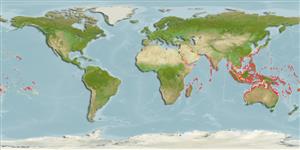Environment: milieu / climate zone / depth range / distribution range
นิเวศวิทยา
เกี่ยวกับทะเล,น้ำเค็ม เกี่ยวกับหินโสโครก; ไม่มีการอพยพย้ายถิ่น; ระดับความลึก 0 - 30 m (Ref. 58304). Tropical; 36°N - 36°S, 28°E - 132°W
Indo-Pacific: East Africa to the Line and Tuamoto islands, north to southern Japan, south to the Lord Howe and the Austral islands. Closely related to Chaetodon decussatus.
ขนาด / น้ำหนัก / Age
Maturity: Lm ? range ? - ? cm
Max length : 23.0 cm TL เพศผู้/กระเทย; (Ref. 9710); common length : 15.0 cm TL เพศผู้/กระเทย; (Ref. 5450)
เงี่ยงครีบหลัง (รวม): 13; ก้านครีบอ่อนที่หาง (รวม): 23-25; เงี่ยงครีบก้น 3; ก้านครีบอ่อนที่ก้น: 19 - 22. This species is distinguished by the following characters: snout length 2.5-3.2 in head length; greatest body depth 1.5-1.7 in SL. Body pattern chevron with narrow lines on side; black band across posterior body which does not include entire rear part of dorsal fin (Ref. 90102).
Adults are found in reef flats, lagoon and seaward reefs and sometimes in turbid waters subject to freshwater runoff swimming in pairs. They are omnivorous, feeding on algae, coral polyps, crustaceans and worms (Ref. 5503). They are oviparous (Ref. 205) and monogamous (Ref. 52884). Stable monogamous pairs with both pair members jointly defending a feeding territory against other pairs (Ref. 58331) occur, but often accompany other species without being aggressive. They are easily maintained in tanks. Minimum depth reported taken from Ref. 128797.
Distinct pairing (Ref. 205). Stable monogamous pairs with both pair members jointly defending a feeding territory. Pelagic larvae settle to shallow (<4 m) back reef habitats consisting of rubble, seagrass and low coral cover (Ref. 58331). Monogamous mating is observed as both obligate and social (Ref. 52884).
Myers, R.F., 1991. Micronesian reef fishes. Second Ed. Coral Graphics, Barrigada, Guam. 298 p. (Ref. 1602)
IUCN Red List Status (Ref. 130435)
Threat to humans
Harmless
Human uses
การประมง: มีการค้าเพียงเล็กน้อย; สถานที่แสดงสัตว์และพืชน้ำ: การค้า
ข้อมูลเพิ่มเติม
อ้างอิงการเพาะเลี้ยงสัตว์น้ำประวัติการเพาะเลี้ยงสัตว์น้ำสายพันธุ์พันธุศาสตร์ElectrophoresesอัตราพันธุกรรมโรคการแปรรูปNutrientsMass conversion
เครื่องมือ
Special reports
Download XML
แหล่งที่มาจากอินเตอร์เน็ต
Estimates based on models
Preferred temperature (Ref.
123201): 24.7 - 29.3, mean 28.4 °C (based on 3294 cells).
Phylogenetic diversity index (Ref.
82804): PD
50 = 0.5000 [Uniqueness, from 0.5 = low to 2.0 = high].
Bayesian length-weight: a=0.01995 (0.01209 - 0.03293), b=2.99 (2.85 - 3.13), in cm total length, based on LWR estimates for this species & Genus-body shape (Ref.
93245).
ระดับชั้นอาหาร (Ref.
69278): 3.4 ±0.29 se; based on food items.
ความสามารถในการกลับคืนสู่ปกติ (Ref.
120179): ความสูง, เวลาต่ำสุดที่จะทำให้ประชากรเพิ่มขึ้นเป็น 2 เท่าใช้เวลาน้อยกว่า 15 เดือน (Preliminary K or Fecundity.).
Fishing Vulnerability (Ref.
59153): Low vulnerability (13 of 100).
Nutrients (Ref.
124155): Calcium = 81.8 [43.3, 126.5] mg/100g; Iron = 0.74 [0.45, 1.17] mg/100g; Protein = 18.5 [17.4, 19.6] %; Omega3 = 0.107 [0.068, 0.165] g/100g; Selenium = 32.4 [18.8, 59.2] μg/100g; VitaminA = 44.8 [13.0, 147.3] μg/100g; Zinc = 1.36 [0.94, 1.94] mg/100g (wet weight);
